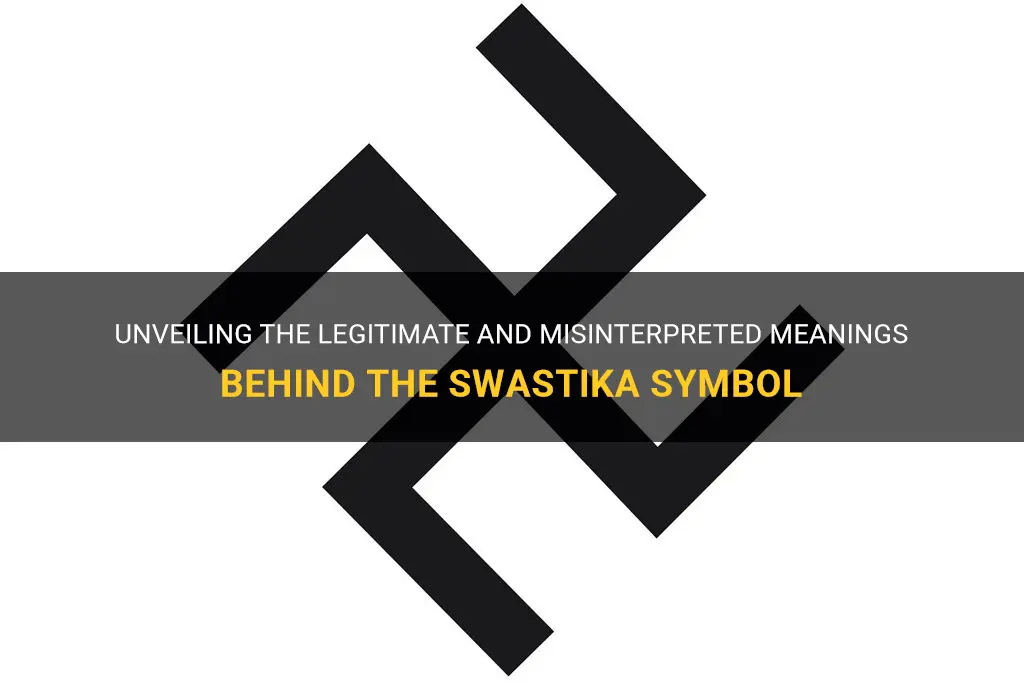
The swastika symbol, a sacred and ancient emblem, has been twisted and tarnished by history, forever associated with one of the darkest and most infamous moments in human history. Yet, before its corruption, the swastika held a profoundly positive and universal significance across various cultures and spiritual traditions. Its roots can be traced back thousands of years, reaching ancient civilizations like the Egyptians, Greeks, and Hindus. In these contexts, the swastika represented notions of life, prosperity, and good fortune, serving as a potent symbol of unity and interconnectedness. Today, grappling with the complex and conflicting meanings of the swastika reminds us of the power symbols hold, both to unite and divide, and challenges us to confront the weight of history as we seek to reclaim its original essence.
What You'll Learn
- What is the historical significance of the swastika symbol and how has its meaning evolved over time?
- How did the Nazis appropriate the swastika symbol and what impact did this have on its meaning?
- Are there any cultures or religions that continue to use the swastika symbol in a non-Nazi context, and what does it represent for them?
- In what ways has the use of the swastika symbol been controversial in modern society, and how have governments and organizations responded?
- Are there any efforts being made to reclaim the swastika symbol and restore its original positive meaning?

What is the historical significance of the swastika symbol and how has its meaning evolved over time?
The swastika is a symbol that has a complex and controversial history. In many cultures, the swastika has been a symbol of good luck and auspiciousness for thousands of years. However, in the 20th century, it became associated with the Nazi party and Adolf Hitler, forever changing its meaning and causing it to become one of the most reviled symbols of hatred and bigotry.
The swastika has its roots in ancient civilizations such as the Indus Valley Civilization and is believed to have been used as a symbol of the sun, representing life, energy, and good fortune. It can be found in religious and cultural contexts in various parts of the world, including Hinduism, Jainism, and Buddhism. In these contexts, the swastika is seen as a positive symbol representing prosperity, well-being, and blessings.
The word "swastika" comes from the Sanskrit word "svastika," which means well-being or good fortune. The symbol itself is formed by four arms radiating from a center point, creating a square-like shape. The arms of the swastika can be either clockwise or counterclockwise, and the direction has different meanings in different cultures.
Despite its positive historical significance, the swastika's association with the Nazi party during World War II has forever tarnished its image. Adolf Hitler and the Nazis adopted the swastika as their emblem in the 1920s, associating it with their ideology of Aryan supremacy and their racist and genocidal policies. The Nazi swastika, known as the Hakenkreuz, was rotated 45 degrees and placed on a white circle against a red background, becoming a symbol of hatred, violence, and intolerance.
After World War II, the use of the swastika as a symbol was banned in many countries, and it became a criminal offense to display it publicly. This was done to prevent the spread of Nazi ideology and to distance societies from the atrocities committed during the Holocaust. The ban on the swastika remains in place in many countries to this day.
However, there are still some communities and cultures that continue to embrace the swastika in its original, pre-Nazi context. For example, in Hinduism, the swastika is still seen as a sacred symbol and is used in religious ceremonies and decorations. In these cases, it is important to differentiate between the ancient symbol of good luck and the Nazi swastika, which carries a completely different meaning.
In recent years, there has been a debate about whether the swastika should be rehabilitated and reclaimed from its association with the Nazis. Some argue that the symbol predates the Nazis and has a rich cultural history that should be respected. Others argue that its association with hatred and genocide is too strong and that it should never be used again.
Regardless of the ongoing debate, it is clear that the meaning of the swastika has evolved over time. From a symbol of good luck and positivity in ancient cultures to a symbol of hatred and evil during the Nazi era, the swastika's history is a complex and cautionary tale. It serves as a reminder of the power symbols can hold and the importance of understanding their historical context.
Unlocking the Mystical power of the Harp Symbol: The Deeper Meanings Beyond its Musical Significance
You may want to see also

How did the Nazis appropriate the swastika symbol and what impact did this have on its meaning?
The swastika symbol has a long and complex history, with roots in various cultures and religions around the world. However, its most significant association in recent history is with the Nazi Party and Adolf Hitler's regime in Germany during the 1930s and 1940s. Understanding how the Nazis appropriated this symbol and the impact it had on its meaning is crucial to comprehending the extent of their propaganda and the lasting stigma attached to the swastika today.
The swastika itself is an ancient symbol that has been used for thousands of years in different contexts. It can be found in Indian, Asian, and Native American cultures, where it is often associated with good luck, prosperity, and positive energy. The symbol consists of an equilateral cross with its arms bent at right angles, creating a rotation effect.
In the early 20th century, the swastika symbol started to gain popularity across Europe as a general good luck symbol. It was commonly used in various forms of art, architecture, and fashion. Its positive connotations were widespread, and the symbol was not associated with any specific political ideology or group.
However, the Nazis appropriated the swastika symbol for their own purposes. In 1920, Adolf Hitler drew a new version of the swastika, rotating it 45 degrees and placing it on a white circle against a red background. This modified swastika became the official emblem of the Nazi Party and was prominently featured on their flags, uniforms, and propaganda materials.
By adopting the swastika, the Nazis sought to associate their party with a sense of ancient heritage and power. They claimed that the symbol represented the Aryan race, which they believed was superior to other races. Hitler and his followers reinterpreted the swastika to reflect their racist ideology, and it quickly became a rallying symbol for their movement.
The impact of the Nazi appropriation of the swastika was profound. The symbol, once associated with positive meanings, became forever linked to the horrors and atrocities committed by Hitler's regime. The crimes of the Holocaust, along with the countless lives lost in World War II, forever tarnished the swastika's reputation.
Following the defeat of the Nazis in World War II, many countries, including Germany, banned the public display of the swastika due to its association with hate, racism, and genocide. Today, the swastika remains outlawed in several countries, and its display is generally regarded as a hate symbol.
Despite the Nazi appropriation of the swastika, it is essential to remember that the symbol itself predates their usage. In many cultures, the swastika still retains its original positive meanings and continues to be used for spiritual and religious purposes. However, the shadow of the Nazi regime looms large over the symbol, making it difficult to separate the two in the collective consciousness.
While the swastika's original meanings persist in some cultures, its association with the Nazis and their atrocities has undeniably impacted its global perception. The appropriation of the swastika by Hitler and the Nazis serves as a stark reminder of the power of symbolism and the lasting impact it can have on society.
The Symbolic Meaning of Elephant: Power, Wisdom, and Family
You may want to see also

Are there any cultures or religions that continue to use the swastika symbol in a non-Nazi context, and what does it represent for them?
The swastika is a symbol that has been used for thousands of years by various cultures and religions around the world. While most people today associate the swastika with the atrocities committed by the Nazis during World War II, the symbol has a very different meaning for these other cultures.
One of the cultures that continue to use the swastika symbol is Hinduism. In Hinduism, the swastika is known as the "swastik" or "svastika" and is one of their most sacred symbols. It represents good fortune, prosperity, and auspiciousness. It is often used in religious rituals, ceremonies, and on temples and homes as a symbol of good luck.
The use of the swastika in Hinduism predates the Nazi regime by thousands of years. It can be found in ancient Hindu scriptures, mythology, and artwork. The swastika is believed to have originated as a representation of the sun and its life-giving energy. It is a symbol of positive energy, harmony, and the cycle of life.
Buddhism is another religion that uses the swastika symbol in a non-Nazi context. In Buddhism, the swastika is known as the "Wan" symbol and is associated with the footprints of Buddha. It represents the Buddha's teachings and is considered a symbol of auspiciousness and spiritual well-being. The swastika can be seen on Buddhist temples, statues, and texts as a reminder of the Buddha's teachings and the path to enlightenment.
Aside from Hinduism and Buddhism, the swastika also holds significance in other cultures. In Jainism, it represents the four stages of spiritual progress, while in Native American tribes, it is associated with the sun, the four directions, and the cycle of life. The swastika can also be found in ancient Greek and Roman art, where it represents good luck and protection.
It is important to understand that these cultures and religions have been using the swastika symbol for centuries, long before its association with the Nazi party. For them, the swastika represents positive values such as prosperity, spirituality, and good fortune. It is a symbol deeply rooted in their cultural and religious beliefs, and they continue to use it in a non-Nazi context.
However, due to the strong association of the swastika with Nazi ideology and the atrocities committed during World War II, its use outside of these cultures and religions is highly controversial and often considered offensive. Many countries, including Germany and Austria, have banned the public display of the swastika in an effort to distance themselves from the Nazi regime.
In conclusion, several cultures and religions continue to use the swastika symbol in a non-Nazi context. For them, the swastika represents positive values such as good fortune, prosperity, spirituality, and the cycle of life. It is essential to understand that the swastika has a diverse history and meaning, and its association with the Nazi party should not overshadow its significance in other cultures and religions.
Unveiling the Hidden Symbolism and Meaning Behind Tulips
You may want to see also

In what ways has the use of the swastika symbol been controversial in modern society, and how have governments and organizations responded?
The swastika is an ancient symbol that has been used for centuries in various cultures around the world. However, its association with the Nazi regime in Germany during World War II has forever tarnished its image and made it one of the most controversial symbols in modern society. The Nazi party used the swastika as their emblem, turning a once sacred and positive symbol into a representation of hatred, violence, and genocide.
The controversy surrounding the swastika stems from its association with the Holocaust, where six million Jews were systematically murdered by the Nazis. The swastika became synonymous with the atrocities committed during this time, and it continues to evoke strong emotions and negative connotations to this day.
Governments and organizations around the world have taken various measures to combat the use and display of the swastika symbol. In many countries, the public display of the swastika is strictly prohibited, and individuals found using the symbol can face legal consequences. Germany, for example, has banned the public display of the swastika since the end of World War II. The use of the swastika in Germany is considered a criminal offense and can result in fines or imprisonment.
In addition to legal measures, organizations and communities have also taken action to counter the influence of the swastika symbol. Education and awareness campaigns have been launched to educate the public about the history and significance of the swastika, emphasizing its ancient origins and its misuse by the Nazis. These efforts aim to prevent the swastika from being seen as a harmless symbol or a form of cultural appropriation, and instead highlight the pain and suffering it represents for millions of people.
Furthermore, organizations dedicated to promoting tolerance and fighting hate speech have also taken a stance against the use of the swastika symbol. Anti-defamation groups work to monitor and combat the spread of hate symbols and propaganda, including the swastika. They work closely with social media platforms and law enforcement agencies to identify and report instances of hate speech and symbol usage, ensuring a safer and more inclusive online environment.
Despite these efforts, however, the swastika continues to be used by hate groups and individuals who align themselves with extremist ideologies. The internet has provided a platform for the spread of hate symbols, including the swastika, allowing these groups to reach a wider audience and promote their ideologies. Governments and organizations must continually adapt and develop new strategies to address the evolving challenges posed by these extremist groups.
In conclusion, the use of the swastika symbol has been highly controversial in modern society due to its association with the Nazi regime and the Holocaust. Governments and organizations have responded by implementing legal measures, educating the public, and working to combat hate speech and extremism. However, the persistence of the swastika's use by hate groups highlights the ongoing need for vigilance and continued efforts to promote tolerance and understanding.
The Profound Symbolism and Meaning behind Elephants: A Closer Look at Their Significance
You may want to see also

Are there any efforts being made to reclaim the swastika symbol and restore its original positive meaning?
In recent history, the swastika symbol has become synonymous with hatred, negativity, and violence due to its association with the Nazi regime during World War II. However, it is important to note that the swastika has a much longer history and a different meaning in various cultures.
The swastika is an ancient symbol that has been used for thousands of years in different parts of the world, including Asia, Europe, and the Americas. Its meaning varies depending on the context and culture in which it is used. In Hinduism, Buddhism, and Jainism, for example, the swastika is considered a sacred symbol representing well-being, good luck, and prosperity. It is often associated with deities and used in religious ceremonies and decorations.
Due to the overwhelming negative association with the swastika, efforts have emerged to reclaim the symbol and restore its original positive meaning. These efforts aim to educate people about the historical significance of the swastika and emphasize its positive connotations to counteract the negative ones.
One such initiative is the "Love the Swastika" campaign, which was launched by the Swastika Rehabilitation movement. The movement seeks to raise awareness about the true meaning of the swastika and promote its positive interpretation. They argue that the Nazi misuse of the symbol should not overshadow its ancient spiritual and cultural significance.
Apart from awareness campaigns, there have been attempts to introduce alternative symbols that resemble the swastika but have distinct designs to avoid confusion. For example, the "Whirling Log" symbol is a modern adaptation of the swastika used by certain Native American tribes to represent harmony and healing. These efforts aim to create new symbols that capture the positive essence of the swastika without triggering negative associations.
Reclaiming the swastika symbol and restoring its original positive meaning is not an easy task. The strong association with Nazi ideology continues to overshadow its ancient symbolism. However, these efforts serve as a reminder that symbols can be appropriated and misused, but their true meanings and historical context should not be forgotten.
Educating people about the origins and diverse interpretations of the swastika is crucial in order to challenge the negative narratives and prejudices associated with it. By understanding its cultural significance, people can distinguish between the Nazi swastika and the ancient symbol, and appreciate its positive connotations in the appropriate context.
It is important to approach the topic sensitively, acknowledging the pain and suffering caused by the Nazi regime, while also promoting a wider understanding of the swastika's historical and cultural significance. Reclaiming the swastika symbol requires a collective effort from both individuals and communities to challenge the negative associations and restore its original positive meaning.
Understanding Flow Chart Symbols and Their Meanings
You may want to see also
Frequently asked questions
The swastik symbol has been used for thousands of years and holds different meanings in various cultures. In Hinduism, it represents good fortune, prosperity, and auspiciousness. In Buddhism, it symbolizes the footsteps of Buddha and is used as a symbol of spiritual awakening. However, it is important to note that in the Western world, the swastik symbol is commonly associated with Nazi Germany and the atrocities committed during World War II.







